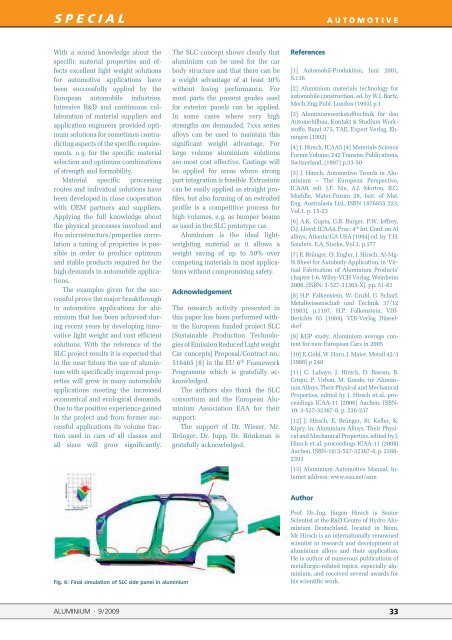special - Alu-web.de
special - Alu-web.de
special - Alu-web.de
Create successful ePaper yourself
Turn your PDF publications into a flip-book with our unique Google optimized e-Paper software.
S P E C I A L<br />
A L U M I N I U M I M A U t o M o b I L<br />
With a sound knowledge about the<br />
specific material properties and effects<br />
excellent light weight solutions<br />
for automotive applications have<br />
been successfully applied by the<br />
European automobile industries.<br />
Intensive R&D and continuous collaboration<br />
of material suppliers and<br />
application engineers provi<strong>de</strong>d optimum<br />
solutions for sometimes contradicting<br />
aspects of the specific requirements,<br />
e. g. for the specific material<br />
selection and optimum combinations<br />
of strength and formability.<br />
Material specific processing<br />
routes and individual solutions have<br />
been <strong>de</strong>veloped in close cooperation<br />
with OEM partners and suppliers.<br />
Applying the full knowledge about<br />
the physical processes involved and<br />
the microstructure/properties correlation<br />
a tuning of properties is possible<br />
in or<strong>de</strong>r to produce optimum<br />
and stable products required for the<br />
high <strong>de</strong>mands in automobile applications.<br />
The examples given for the successful<br />
prove the major breakthrough<br />
in automotive applications for aluminium<br />
that has been achieved during<br />
recent years by <strong>de</strong>veloping innovative<br />
light weight and cost efficient<br />
solutions. With the reference of the<br />
SLC project results it is expected that<br />
in the near future the use of aluminium<br />
with specifically improved properties<br />
will grow in many automobile<br />
applications meeting the increased<br />
economical and ecological <strong>de</strong>mands.<br />
Due to the positive experience gained<br />
in the project and from former successful<br />
applications its volume fraction<br />
used in cars of all classes and<br />
all sizes will grow significantly.<br />
Fig. 6: Final simulation of SLC si<strong>de</strong> panel in aluminium<br />
The SLC concept shows clearly that<br />
aluminium can be used for the car<br />
body structure and that there can be<br />
a weight advantage of at least 30%<br />
without losing performance. For<br />
most parts the present gra<strong>de</strong>s used<br />
for exterior panels can be applied.<br />
In some cases where very high<br />
strengths are <strong>de</strong>man<strong>de</strong>d, 7xxx series<br />
alloys can be used to maintain this<br />
significant weight advantage. For<br />
large volume aluminium solutions<br />
are most cost effective. Castings will<br />
be applied for areas where strong<br />
part integration is feasible. Extrusions<br />
can be easily applied as straight profiles,<br />
but also forming of an extru<strong>de</strong>d<br />
profile is a competitive process for<br />
high volumes, e. g. as bumper beams<br />
as used in the SLC prototype car.<br />
<strong>Alu</strong>minium is the i<strong>de</strong>al lightweighting<br />
material as it allows a<br />
weight saving of up to 50% over<br />
competing materials in most applications<br />
without compromising safety.<br />
Acknowledgement<br />
The research activity presented in<br />
this paper has been performed within<br />
the European fun<strong>de</strong>d project SLC<br />
(Sustainable Production Technologies<br />
of Emission Reduced Light weight<br />
Car concepts) Proposal/Contract no.:<br />
516465 [8] in the EU 6 th Framework<br />
Programme which is gratefully acknowledged.<br />
The authors also thank the SLC<br />
consortium and the European <strong>Alu</strong>minium<br />
Association EAA for their<br />
support.<br />
The support of Dr. Wieser, Mr.<br />
Brünger, Dr. Jupp, Dr. Brinkman is<br />
gratefully acknowledged.<br />
References<br />
A U t o M o t I v E<br />
[1] Automobil-Produktion, Juni 2001,<br />
S.136<br />
[2] <strong>Alu</strong>minium materials technology for<br />
automobile construction, ed. by W.J. Bartz,<br />
Mech. Eng. Publ. London (1993) p.1<br />
[3] <strong>Alu</strong>miniumwerkstofftechnik für <strong>de</strong>n<br />
Automobilbau, Kontakt & Studium Werkstoffe,<br />
Band 375, TAE, Expert Verlag, Ehningen<br />
(1992)<br />
[4] J. Hirsch, ICAA5 (4) Materials Science<br />
Forum Volume, 242 Transtec Publications,<br />
Switzerland, (1997) p.33-50<br />
[5] J. Hirsch, Automotive Trends in <strong>Alu</strong>minium<br />
– The European Perspective,<br />
ICAA9, edt. J.F. Nie, A.J. Morton, B.C.<br />
Muddle, Mater. Forum 28, Inst. of Mat.<br />
Eng. Australasia Ltd., ISBN 1876855 223,<br />
Vol.1, p. 15-23<br />
[6] A.K. Gupta, G.B. Burger, P.W. Jeffrey,<br />
D.J. Lloyd; ICAA4, Proc. 4th Int. Conf. on Al<br />
alloys, Atlanta/GA USA (1994) ed. by T.H.<br />
San<strong>de</strong>rs, E.A. Starke, Vol.3, p.177<br />
[7] E. Brünger, O. Engler, J. Hirsch, Al-Mg-<br />
Si Sheet for Autobody Application, in ‘Virtual<br />
Fabrication of <strong>Alu</strong>minium Products’<br />
chapter I-6, Wiley-VCH Verlag, Weinheim<br />
2006, (ISBN: 3-527-31363-X), pp. 51-61<br />
[8] H.P. Falkenstein, W. Gruhl, G. Scharf,<br />
Metallwissenschaft und Technik 37/12<br />
(1983), p.1197, H.P. Falkenstein, VDI-<br />
Berichte 65 (1984), VDI-Verlag Düsseldorf<br />
[9] KGP study, <strong>Alu</strong>minium average content<br />
for new European Cars in 2005<br />
[10] E. Gold, W. Horn, J. Maier, Metall 42/3<br />
(1988) p 248<br />
[11] C. Lahaye, J. Hirsch, D. Bassan, B.<br />
Criqui, P. Urban, M. Goe<strong>de</strong>, in: <strong>Alu</strong>minium<br />
Alloys, Their Physical and Mechanical<br />
Properties, edited by J. Hirsch et. al. proceedings<br />
ICAA-11 (2008) Aachen, ISBN-<br />
10: 3-527-32367-8, p. 236-237<br />
[12] J. Hirsch, E. Brünger, St. Keller, K.<br />
Kipry, in: <strong>Alu</strong>minium Alloys, Their Physical<br />
and Mechanical Properties, edited by J.<br />
Hirsch et. al. proceedings ICAA-11 (2008)<br />
Aachen, ISBN-10: 3-527-32367-8, p. 2388-<br />
2393<br />
[13] <strong>Alu</strong>minium Automotive Manual, Internet<br />
address: www.eaa.net/aam<br />
Author<br />
Prof. Dr.-Ing. Jürgen Hirsch is Senior<br />
Scientist at the R&D Centre of Hydro <strong>Alu</strong>minium<br />
Deutschland, located in Bonn.<br />
Mr Hirsch is an internationally renowned<br />
scientist in research and <strong>de</strong>velopment of<br />
aluminium alloys and their application.<br />
He is author of numerous publications of<br />
metallurgic-related topics, e<strong>special</strong>ly aluminium,<br />
and received several awards for<br />
his scientific work.<br />
33 ALUMINIUM · 9/2009<br />
ALUMINIUM · 9/2009 33
















